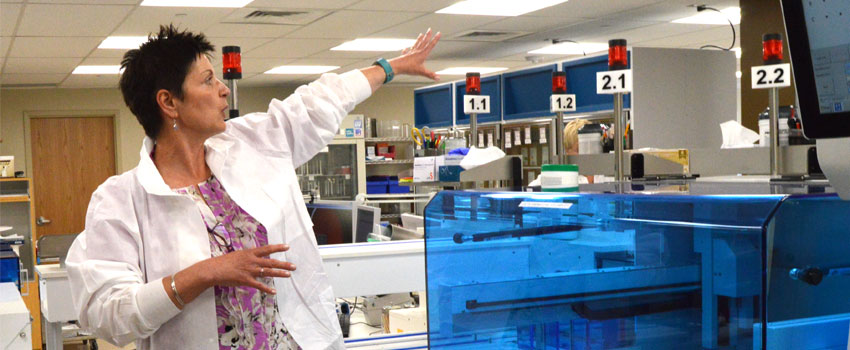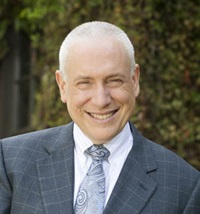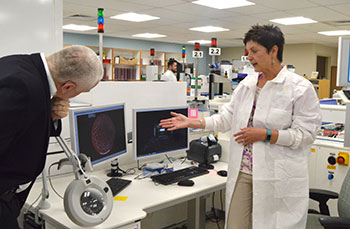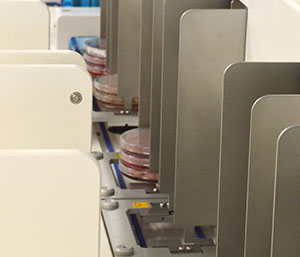Dr. Pate’s Prescription for Change
St. Luke’s Lab Makes a Jump to Better and Faster Results



I recently had the opportunity to tour St. Luke’s Core Laboratory and see our new technology and automation in action. It was simply amazing.
I remember streaking agar plates as a medical student and performing countless gram stains on the specimens from my patients as a resident. You could tell when I had been performing gram stains because my fingertips were stained purple.
At St. Luke’s, a machine now does all of this for us, at a higher quality and in a shorter amount of time.
In the past, when I was treating a patient with a severe infection, I would have them on my best guess for antibiotics for 48 to 72 hours until the lab could tell me precisely what we were dealing with and what the best treatment would be.
Today, our systems can shorten this time to 10 to 15 hours. This is better care at a lower total cost, and it likely will save lives and decrease complications.
Here to tell you more about this amazing progress – St. Luke’s is only the fifth health system in the country to have this type of technology – is Communications Coordinator Chereen Langrill.
- David C. Pate, M.D., J.D.

Typically, the longer it takes to treat an aggressive illness or infection, the worse it gets. Factor in the risk of additional complications, or even death, and a health problem that might have been much more manageable earlier can become a high-stakes exercise. And while the severity of the illness continues to increase, so does the cost for treatment.
A vital link to a faster diagnosis is the lab. The laboratory plays a critical role in managing illness and infection, because more than 50 percent of all medical decisions are based on lab results.
And yet over the past 30 years as medicine has evolved, the field of microbiology has remained unchanged. For patients seeking solutions when they were ill and didn’t know why, this has meant waiting 24 hours or longer to learn about a diagnosis and treatment that could help them feel better. Sometimes, that treatment might mean the difference between life and death.
In March, St. Luke’s became one of just a few organizations in the country to automate its microbiology laboratory platform, cutting wait times in half.
The technology gives patients across the health system access to a level of testing that produces faster results. This sophisticated platform benefits all patients, especially the very young, those receiving cancer treatment and patients fighting sudden, life-threatening infections.
“We have significantly reduced our time to identify the cause of infection, resulting in patients getting the right antibiotic sooner,” said Mary Cronin, St. Luke’s senior director of Support Services.
Prior to automation, traditional microbiology laboratory tests were done through a manual process that that would take several days for results; results now takes 24 hours or less.
“When you’re talking about really sick people and making sure they are on the right antibiotic, it’s really important we have the best in class available for our community,” Cronin said.

Examples of how automated testing is making a difference for patients:
- Using the traditional lab process, it would take 24 hours to read a urine specimen; now it takes 12 hours.
- Better incubation allows for the differentiation of multiple bacteria; previously, the many manual tasks required delayed the time for result availability.
- A robotic track places the plates into a smart incubator and takes digital pictures when plates are ready for inspection. Technologists only retrieve the plates that indicate infection.
Additional molecular technology has been added to improve in the accuracy and waiting time for diagnosis of infectious disease. Identification of Clostridium difficile (C. diff), MRSA (methicillin resistant S. Aureus), Herpes Simplex and Herpes Zoster, and parasitic and bacterial gastro intestinal infections like Salmonella, Giardia and others occurs within hours instead of days. Future enhancements include screening for antibiotic resistance genets that will lead to better treatment and faster recovery time for patients.
“It takes less time and gets better results for patients,” Cronin said.
The technology is another way St. Luke’s is working to improve patient outcomes and lower the total costs of care, in this instance by supporting better and more precise diagnoses and treatments.
“The inappropriate use of overly broad-spectrum antibiotics is an important cause of morbidity and excessive cost in the care of the critically ill,” said Dr. Jim Souza, St. Luke’s chief medical officer. “Enhanced time to accurate microbiologic identification gives us the opportunity to improve on both of these.”
For Cronin, lab automation was a no-brainer: faster, more efficient, at a lower cost and with better results. As she began researching lab automation and its many benefits, it didn’t take long for her to realize St. Luke’s was ready to take that step.
“We know our business needs to evolve and we need to embrace technology,” Cronin said.
About The Author

Chereen Langrill was formerly a communications coordinator for St. Luke’s Health System.

